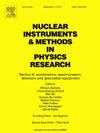Radiation portal monitor data file format for comprehensive background radiation monitoring
IF 1.5
3区 物理与天体物理
Q3 INSTRUMENTS & INSTRUMENTATION
Nuclear Instruments & Methods in Physics Research Section A-accelerators Spectrometers Detectors and Associated Equipment
Pub Date : 2025-04-05
DOI:10.1016/j.nima.2025.170516
引用次数: 0
Abstract
Radiation portal monitors (RPMs) are widely used at border security checkpoints to detect the presence of radioactive materials in people, vehicles, and cargo. Typically, RPM detection systems consist of two pillars equipped with gamma and neutron detectors. To improve detection efficiency, RPMs employ techniques such as a limited energy window, dynamic alarm thresholds, and lead shielding. However, without continuous monitoring of background radiation, signal interpretation can be compromised, because environmental factors and mechanical failures can cause fluctuations. Here, we introduce a daily file format that logs gamma background and neutron background radiation levels continuously over a 24 h period; this format is different from traditional formats that record data only when the RPM is active or occupied. The approach enables RPM operators and analysts to (1) identify and diagnose malfunctioning components, (2) adjust system settings to account for dynamic environmental factors, and (3) use the recorded data to characterize outer space phenomena. Continuous background reporting is essential for identifying issues such as faulty connections, voltage divider failures, and errors in background updates. Continuous background reporting also enables the detection of external influences, including nearby X-ray scanners, temperature fluctuations, rainfall, cosmic radiation, and lunar phase changes. These data files are designed to be easily evaluated and parsed using common tools, and a quick review by an expert is often sufficient for problem diagnosis. We anticipate that continuous background radiation monitoring and these new strategies will significantly improve the accuracy and reliability of RPM systems, reducing the rate of false alarms and enhancing overall system performance.
辐射门户监测数据文件格式,用于全面的本底辐射监测
辐射门户监测器(RPM)被广泛用于边境安全检查站,以检测人员、车辆和货物中是否存在放射性物质。通常情况下,RPM 检测系统由两个装有伽马和中子探测器的支柱组成。为了提高探测效率,RPM 采用了有限能量窗口、动态警报阈值和铅屏蔽等技术。然而,由于环境因素和机械故障会导致信号波动,如果不对本底辐射进行持续监测,信号解读就会受到影响。在此,我们引入了一种每日文件格式,可在 24 小时内连续记录伽马本底辐射和中子本底辐射水平;这种格式不同于传统的格式,后者仅在旋转变电站处于活动状态或被占用时记录数据。这种方法可使转 换站操作员和分析人员 (1) 识别和诊断故障部件,(2) 调整系统设置以考虑动态环境因 素,以及 (3) 利用记录的数据描述外层空间现象的特征。连续的背景报告对于发现诸如连接故障、分压器故障和背景更新错误等问题至关重要。连续的背景报告还能检测外部影响,包括附近的 X 射线扫描仪、温度波动、降雨、宇宙辐射和月相变化。这些数据文件的设计便于使用普通工具进行评估和解析,专家的快速审查通常足以进行问题诊断。我们预计,持续的本底辐射监测和这些新策略将大大提高 RPM 系统的准确性和可靠性,降低误报率,提高系统的整体性能。
本文章由计算机程序翻译,如有差异,请以英文原文为准。
求助全文
约1分钟内获得全文
求助全文
来源期刊
CiteScore
3.20
自引率
21.40%
发文量
787
审稿时长
1 months
期刊介绍:
Section A of Nuclear Instruments and Methods in Physics Research publishes papers on design, manufacturing and performance of scientific instruments with an emphasis on large scale facilities. This includes the development of particle accelerators, ion sources, beam transport systems and target arrangements as well as the use of secondary phenomena such as synchrotron radiation and free electron lasers. It also includes all types of instrumentation for the detection and spectrometry of radiations from high energy processes and nuclear decays, as well as instrumentation for experiments at nuclear reactors. Specialized electronics for nuclear and other types of spectrometry as well as computerization of measurements and control systems in this area also find their place in the A section.
Theoretical as well as experimental papers are accepted.

 求助内容:
求助内容: 应助结果提醒方式:
应助结果提醒方式:


